Nimrod Racing Automobiles was a partnership founded in 1981 between racing driver and car dealer Robin Hamilton and chairman of Aston Martin Lagonda, Victor Gauntlett. The project was intended to build sports prototypes for the World Endurance Championship and IMSA GT Championship using Aston Martin V8 engines. Although Aston Martin did not own the project, they offered their support for the chance to see success for their name in motorsports without the heavy cost of running their own team.

The 1989 24 Hours of Le Mans was the 57th Grand Prix of Endurance, taking place at the Circuit de la Sarthe, France, on the 10 and 11 June 1989. This year it was not included as a round of the 1989 World Sports-Prototype Championship. The entry list promised a strong contest between five manufacturers. Jaguar had won in 1988 and went on to win the championship; while Sauber had finished second and was now matching Jaguar on the track. New regulations were coming in 1991, and the first examples of the 3.5-litre normally-aspirated formula were entered by Spice Engineering.

The 1962 24 Hours of Le Mans was a motor race for Experimental cars and Grand Touring cars, staged at the Circuit de la Sarthe, Le Mans, France on 23 and 24 June 1962. It was the 30th Grand Prix of Endurance and the eighth round of the 1962 International Championship of Manufacturers.

The Maserati 450S is a racing car made by Italian automobile manufacturer Maserati for participating in FIA's endurance World Sportscar Championship racing. A total of nine were made.
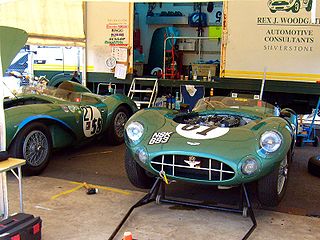
The Aston Martin DBR1 is a sports racing car built by Aston Martin starting in 1956, intended for the World Sportscar Championship as well as non-championship sportscar races at the time. It is most famous as the victor of the 1959 24 Hours of Le Mans, Aston Martin's only outright victory at the endurance classic. It is one of only three cars in the 1950s to win both the World Sports Car Championship and Le Mans 24 Hours in the same year. In addition the six World Sports Car Championship victories was a record for any car in the 1950s and remained a record in the championship until surpassed by the Ferrari 250TR. The three consecutive triumphs in 1959 at the Nürburgring, Le Mans and the Tourist Trophy equalled the record set by the Ferrari 250TR with its three consecutive victories at the start of the 1958 season.

Ray Mallock Ltd., also known as RML Group, is a motorsports and high performance engineering company, based in Wellingborough, Northamptonshire, United Kingdom.
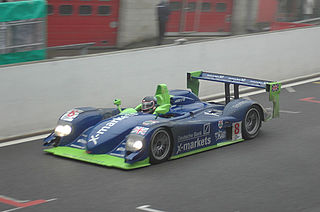
The Dallara SP1, also known as the Chrysler LMP, was a Le Mans Prototype built by Italian firm Dallara. Initially used as part of Chrysler Corporation's attempt to win the 24 Hours of Le Mans, the cars were later sold to customers for use series such as the FIA Sportscar Championship and Le Mans Series.

The MG-Lola EX257 is a Le Mans Prototype racing car built by Lola for the MG car company for their attempt to compete again at the 24 Hours of Le Mans in 2001. The car has had many years of mixed success since its introduction, even in privateer hands.

The Lola B98/10 was a Le Mans Prototype built by Lola Cars International for use in the International Sports Racing Series, American Le Mans Series, and 24 Hours of Le Mans. It would be the first international sports car built by Lola since they briefly left the sport in 1992 following the Lola T92/10. It would be succeeded in 2000 by the Lola B2K/10.

The Lola B08/60 is a Le Mans Prototype built by Lola Cars International. It is the first closed-cockpit sports prototype built by Lola since the 1992 T92/10. It started competition in 2008, with Aston Martin being among the first customers for their entry into the LMP1 category in Le Mans Series, albeit entering under Charouz Racing System banner.

The Chevrolet Corvette C6.R is a grand tourer racing car built by Pratt Miller and Chevrolet for competition in endurance racing. It is a replacement for the Corvette C5-R racing car, applying the body style of the new C6 generation Chevrolet Corvette as well as improvements to increase the speed and reliability on the track. Since its debut in 2005, it has continued on from the previous dominance of the C5-R in its racing class with multiple American Le Mans Series championships and race wins in the Le Mans Series, FIA GT Championship, and 24 Hours of Le Mans. There are two main versions of the Corvette C6.R: the GT1 version which has 590 HP, carbon-ceramic brakes, and aggressive aerodynamics, and the GT2 version which has 470 HP, cast-iron brakes, and relatively stock aerodynamics with respect to the road car. Unrestricted though, the LS7.R engine will produce around 800 hp. By 2012 the C6.R GT1 was retired from the competition while the GT2 version continues to race around the world.
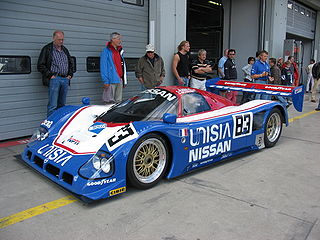
The Nissan R90C was a platform used for Group C racing cars built in 1990 by Nissan Motors for competition in World Sportscar Championship (WSC) based in Europe and the All Japan Sports Prototype Championship (JSPC). The cars based on the basic R90C platform would compete until 1993 before Nissan chose to withdraw from sports car racing, not returning until 1997. It won three JSPC championships and several significant endurance races during its career.

The Nimrod NRA/C2 was the only Group C racing car ever built by Nimrod Racing Automobiles in partnership with Aston Martin. It ran initially in 1982 in the World Endurance Championship before also joining the IMSA GT Championship. The final NRA/C2 would be retired in 1984 after the planned NRA/C3 replacement had been cancelled, and the company went bankrupt.
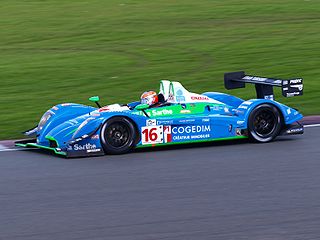
The Pescarolo 01 was the first sports prototype racing car built entirely by French team Pescarolo Sport. It had been designed to meet the LMP1 and LMP2 regulations for Le Mans Prototypes in the Le Mans Series as well as at the 24 Hours of Le Mans, and replace Pescarolo's previous C60 chassis which had been heavily modified from cars purchased through Courage Compétition. The 01s debut was at the 2007 1000 km of Monza.

The Aston Martin RHAM/1 was a highly modified Aston Martin DBS V8 racing car, developed by Robin Hamilton, built with the intention of racing at the 24 Hours of Le Mans. After development by Hamilton, RHAM/1 competed in the 1977 and 1979 24 Hours of Le Mans, finishing 17th overall and 3rd in the GTP class in the 1977 race. The car has also held the World Land Speed Record, for towing a caravan, at the speed of 124.91 mph.

The Aston Martin Vantage GT2 is the most powerful racing variant of the Aston Martin V8 Vantage family. The Vantage GT2 is based on the V8 engined Aston Martin Vantage road car but is designed to run on both standard race fuel or E85 bio-ethanol.

The Debora LMP296 was a Le Mans Prototype, built by Debora Automobiles in 1996 for use in the 24 Hours of Le Mans. The car was originally entered with a 2-litre turbocharged Cosworth straight-four engine, but several other engines were used in the car's three-year career. Two cars are known to have been built. In conjunction with the LMP297, the car helped Waterair Sport to the International Sports Racing Series SR2 Team's Championship in 1998. The LMP296 was updated into the LMP299 for 2000.
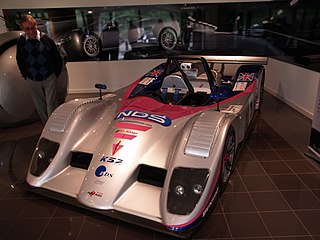
The Ascari A410 was a Le Mans Prototype built by Ascari Cars in 2000. The car, which was based on the Lola T92/10 Group C racing car, featured a 4-litre Judd GV4 V10 engine, and was used in European and international sports car racing events. In 2002, it was renamed as the Ascari KZR-1.

The CLM P1/01, renamed ENSO CLM P1/01 in 2017, is a sports prototype racing car built for Lotus Racing in 2014. The Lotus team entered the last five rounds of the World Endurance championship in 2014, but later took name as the Austrian based team ByKolles Racing. It is designed to meet the 2014 LMP1-L regulations for Le Mans Prototypes in the FIA World Endurance Championship as well as at the 24 Hours of Le Mans. The P1/01 debuted at the 2014 6 Hours of Circuit of the Americas, round four of the FIA World Endurance Championship.

Aston Martin has made a number of mechanically similar V8 engines over the years, since the first one used in the Aston Martin V8 in 1969. They have been both naturally-aspirated and supercharged.





















